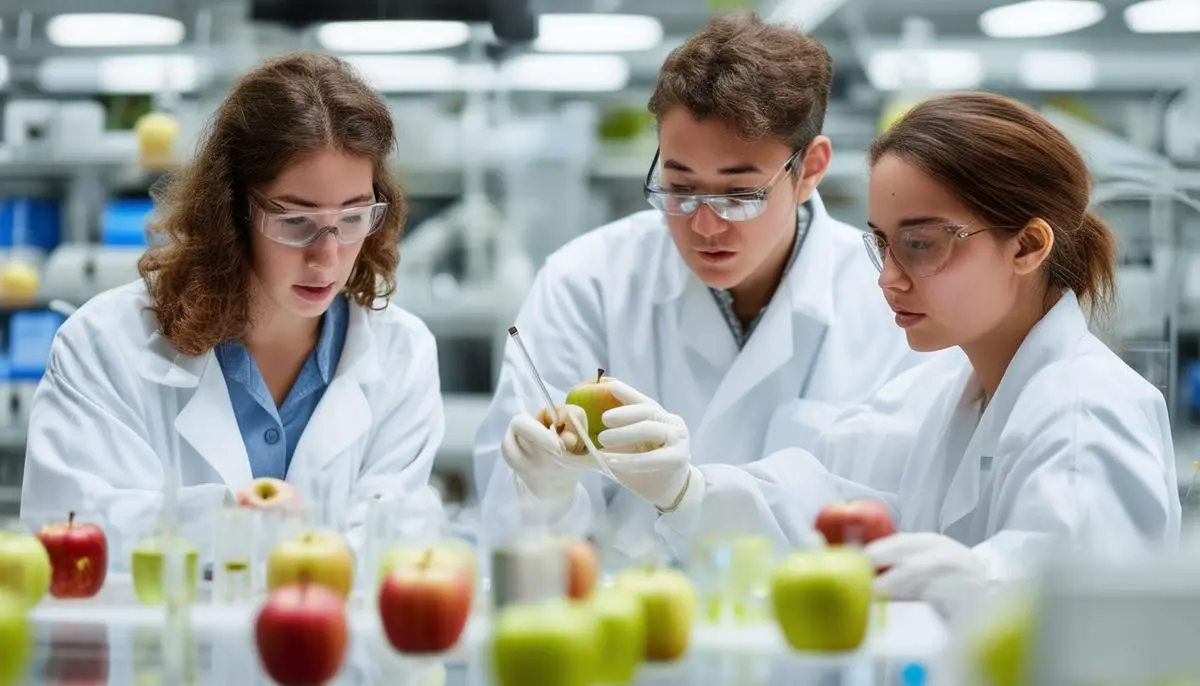Apple industry associations play a crucial role in shaping the apple market. Their efforts span from research and development to advocacy, marketing, and education. These organizations work to keep apples at the forefront of consumer choices, ensuring high-quality produce while supporting sustainable practices.
Research and Development
Research and Development (R&D) within the apple industry is a big deal orchestrated by apple industry associations. These organizations pour money and expertise into various projects, aiming to supercharge apple production.
Funding allocation is the lifeblood of these R&D ventures. Disease control tops the list. Associations fund genetic studies and biotechnology to fend off apple-loving pests. Think of it as a high-stakes chess game against nature, where every move counts.
New apple varieties are another focus. Creating a new apple isn't just slapping two seeds together and hoping for the best. It's an art form! These associations invest in cross-breeding programs to churn out apples that make your taste buds sing. Picture a Honeycrisp marrying a Fuji and producing offspring that's the apple world's equivalent of a rock star.
Efficient growing techniques also get a hefty slice of funding. Drip irrigation, soil health, and energy-efficient storage solutions aren't just buzzwords—they're game-changers. Apple industry associations explore advanced agricultural practices to boost yield and quality.
Benefits for Apple Growers:
- Improved disease control methods
- New, resilient apple varieties
- Efficient growing techniques
- Lower production costs
- Decreased environmental footprint
Ultimately, the result is a market brimming with high-quality, competitive apples that your grandma would be proud of. Each bite into these scientifically fine-tuned beauties brings you a taste of R&D magic, ensuring a crisp, delicious experience.

Advocacy and Policy Influence
Advocacy and policy influence are like the unsung heroes safeguarding your favorite crispy snack. Apple industry associations spend countless hours making sure the apple industry thrives in a competitive world.
Key Areas of Focus:
- Trade Agreements: Securing favorable terms for U.S. apples in international markets
- Essential Resources: Lobbying for water rights and labor availability
- Agricultural Policies: Pushing for subsidies, research grants, and infrastructure development
- Public Health Policies: Advocating for apples in school lunch programs
Imagine apple diplomats trekking around the world, negotiating trade deals that ensure American apples land on dining tables from Paris to Tokyo. By securing favorable trade terms, they expand market horizons and open up new avenues for U.S.-grown apples.
On the labor front, these associations support visa programs for seasonal workers, easing the labor crunch and ensuring no apple is left hanging on the tree. They act as the industry's megaphone, broadcasting the needs and challenges of apple growers to legislators.
"Advocacy in action keeps apples on your plate and supports the livelihood of countless growers and workers in the industry."
So, next time you bite into a crisp, juicy apple, remember the tireless work behind the scenes that keeps it on your plate. It's advocacy in action, doing the heavy lifting to maintain and elevate the apple's place in our hearts and homes. Cheers to that! 🍎

Marketing Initiatives
Apple industry associations are like the rockstars of the fruit world, with a fanbase that stretches across continents. They know how to craft campaigns that make apples the Beyoncé of the produce aisle—undeniably appealing and always in the spotlight.
Key Marketing Strategies:
- Large-scale marketing campaigns
- Participation in trade fairs
- Promotional activities (e.g., apple festivals, social media campaigns)
- Establishment of quality standards
Large-scale marketing campaigns are the headliners. Picture billboards showcasing glossy apples that look so good you can almost taste their crunch. TV commercials showing families enjoying apple slices at the breakfast table, kids munching on apples during playground breaks, and chefs whipping up delectable apple desserts.
Participation in trade fairs is yet another dazzling act. Imagine an apple booth at a global food expo, glistening with perfectly arranged apple pyramids, offering samples of the latest Honeycrisp-Fuji hybrid that tastes like a burst of autumn in your mouth.
Promotional activities are the jazz improvisations in this marketing symphony. Think apple festivals that turn orchard visits into full-blown experiences. Families flock to these events to pick apples, enjoy apple-themed games, and maybe even catch an apple-eating contest.
The establishment of quality standards is another key aspect. Apple industry associations set rigorous standards that ensure only the cream of the crop makes it to market. These standards cover everything from size and color to sweetness and crunch, ensuring each apple that hits the store shelves is nothing short of excellent.
All these marketing initiatives skyrocket domestic and international demand for apples. They create a buzz that makes apples a must-have, whether you're shopping at your local farmer's market or browsing a supermarket in a foreign country.
So, next time you sink your teeth into that juicy apple, remember—it's not just a piece of fruit. It's the star of an all-year-round marketing show that keeps you coming back for more. 🍏

Education and Training Programs
Apple industry associations roll out the red carpet with a variety of workshops, seminars, and other training programs designed to turn apple growers and marketers into veritable wizards of their craft.
Types of Educational Offerings:
- Workshops and seminars
- Advanced training programs
- Specialized topic explorations
Workshops and seminars are epic knowledge fests that bring together the best minds in the apple business. Imagine sitting in a packed room, surrounded by fellow apple enthusiasts, while top-notch agronomists and marketers dish out the latest secrets in apple cultivation and sales.
Apple industry associations also host advanced training programs that go beyond the basics, exploring specialized topics. Think of these as the Harvard of apple education. You might attend a multi-day series on advanced grafting techniques, where you get to experiment with creating the next superstar apple variety.
Impact on the Industry:
- Increased efficiency in apple production
- Enhanced marketing strategies
- Improved disease management
- Adoption of precision farming techniques
- Better understanding of customer preferences
These educational programs are game-changers in the industry. They equip apple growers with the tools needed to increase efficiency right from the planting phase to the moment the apples hit the shelves. Imagine a world where each apple tree in your orchard produces more fruit than ever before, thanks to newly acquired disease management strategies and precision farming techniques.
Ultimately, these educational efforts lead to a more knowledgeable and skilled workforce, which elevates the entire industry. When growers are armed with the latest techniques and marketers are brimming with fresh strategies, the whole apple ecosystem flourishes. The increased efficiency and profitability trickle down to consumers, who get better apples at better prices.
So, next time you bite into a juicy, perfectly crisp apple, remember—it might just be the product of someone's hard-earned knowledge from one of these exceptional educational programs. That burst of flavor isn't just delicious; it's a testament to the relentless pursuit of excellence championed by apple industry associations. Cheers to learning and the delicious fruits of that labor! 🍎

In essence, apple industry associations are pivotal in maintaining the apple's esteemed place in our diets and markets. Their comprehensive approach—from R&D to marketing—ensures that each bite of an apple is not just delicious but also a testament to dedicated efforts behind the scenes.
- Brown SK, Maloney KE. Genetic improvement of apple: breeding, markers, mapping and biotechnology. In: Ferree DC, Warrington IJ, eds. Apples: Botany, Production and Uses. CABI Publishing; 2003:31-59.
- Gómez MI, McLaughlin EW, Wittink DR. Customer satisfaction and retail sales performance: an empirical investigation. Journal of Retailing. 2004;80(4):265-278.
- Braun HJ, Atlin G, Payne T. Multi-location testing as a tool to identify plant response to global climate change. Climate Change and Crop Production. 2010;1:27-45.
- Yue C, Gallardo RK, Luby J, et al. An investigation of United States apple producers' trait prioritization—evidence from audience surveys. HortScience. 2013;48(11):1378-1384.
- Wismer WV, Harker FR, Gunson FA, et al. Replacing a 'Granny Smith' apple cultivar by a new cultivar: how do consumers perceive this change? Postharvest Biology and Technology. 2005;36(2):163-172.